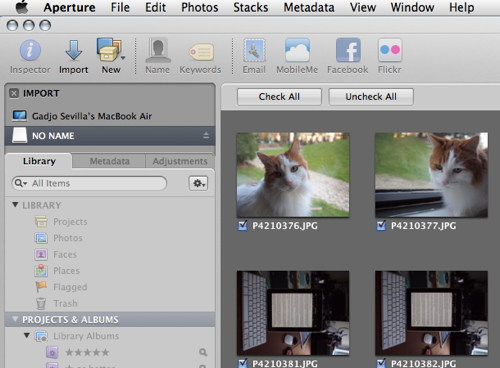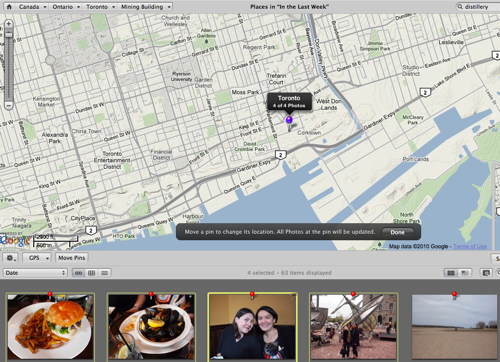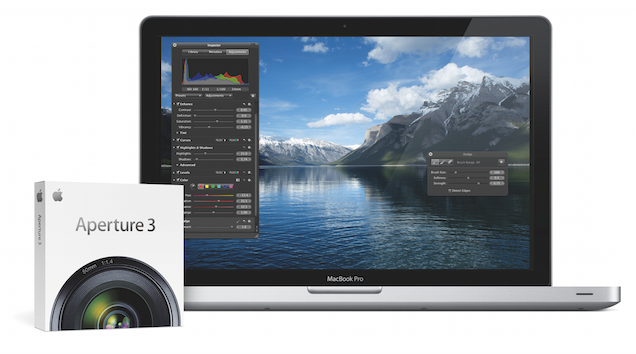Review: Apple Aperture
 Saturday, May 1, 2010 at 11:20AM
Saturday, May 1, 2010 at 11:20AM  By Gadjo Cardenas Sevilla
By Gadjo Cardenas Sevilla
We’ve been testing Apple’s Aperture 3 photo management software for a little over a month and as we integrated it into our day-to-day photography workflow, we realized that it is a well-rounded and thoughtful application that’s designed to appeal to novices as well as professionals, which if you think about it is a daunting task.
Aperture, which sells for $219, offers users a non-destructive photo editing and management tool that’s a one-stop-shop for photos. For an application that started out as a purely prosumer-oriented shooter’s tool it has been revised to be simpler to use but with all the control you could possibly need under the hood.

A first look reveals a more user-oriented interface that will be familiar to iPhoto users. The biggest things we’ll notice is the placement of buttons for direct upload to Facebook, Flickr, Apple’s own MobileMe service plus a direct link to your email program.
It’s clear that quick organization, the ability to enable on-the-fly touchups and more importantly the capability to share photos quickly through a wide variety of social media and web-based services is the key focus of Aperture 3.
Aperture seems to run in the background by default and comes to life as soon as a camera or a memory card is sensed by OS X. Once Aperture is activated, it automatically reads the card and generates thumbnails of all the images that are present. This give you the option of weeding out images even before you even start importing them.
Aperture 3 gives users the option of storing your images wherever you like. Dealing with a lot of large RAW files, we opted to get images stored on an external drive and this worked well. You can manage hundreds of thousands of photos easily thanks to the application’s search capability and its intuitive navigation. Spend a little time organizing by date, subject, place, camera and you’ll soon tidy up your photo collection.

Aperture 3 has also brought iPhoto’s Faces and Places features. Faces automatically scan and tags photos by faces so it makes it easy to search by person. We found the Faces feature to be generally accurate although like most facial recognition software it tends to have some difficulty dealing with poorly exposed photos.
Places works in a similar way but deals with location and is ideal for cameras that have a GPS location capability, for the rest of us, you need to manually tag your photos based on location. It is easy enough to do as the feature is powered by Google Maps, which many users are already familiar with. Nothing revolutionary, but definitely a cool feature to have.
Many Aperture 3 features are easy to miss, like the full screen browser which allows for live-views of any adjustments or edits you may be making so you see changes accurately (this is done on a copy of the original so even if you mess it up you can start all over again).
We’re avowed Photoshop users and while we feel more comfortable in Adobe’s interface, Aperture has proven to be very useful for quick and accurate edits. Below are a series of quick videos showing how quick and responsive adjustments can be in Aperture 3.
We also discovered that there are dozens of third-party plugins that can enhance Aperture for specific types of photos manipulation. We tried Toon-It which re-colours photos in such a way that they resemble comic books. This open system allows for photographers to tailor their digital darkroom and use a variety of effects to enhance their images.

Overall, we’re liking Aperture 3 and its tight integration with our Macs as well as the vast amount of control for the application. It is a deep and complex program but made simple by its interface and we will need to spend a lot more time to figure out all of its functionality.
One caveat and the source of some frustration is that the proprietary RAW formats of newer cameras are not always supported right away. We had a hard time working with RAW images shot on a Canon Digital Rebel 2Ti as well as the Olympus PEN E-PL1. The recent Aperture update took care of the Canon problem but Olympus is still unreadable by Aperture. Another reason to push for a RAW digital negative standard across camera manufacturers.
If you’re happy with iPhoto and are comfortable with the feature set, then that’s fine. For more advanced photo management and organization plus editing features, Aperture 3 is worth a look as a multifaceted solution to photo management, light editing and creative workflow.
Rating: 4 out of 5 stars





















Reader Comments